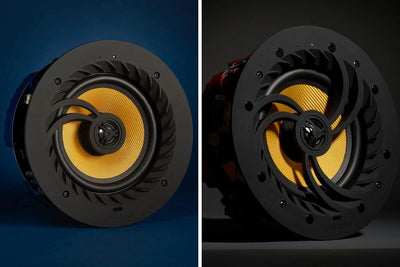If you’re considering adding ceiling speakers to your home then you may be wondering whether you need to add a subwoofer or not.
Do ceiling speakers need a subwoofer?
Ceiling speakers don’t require a subwoofer to provide a great sound quality, however adding a subwoofer can dramatically improve your experience by filling in the lower frequencies, adding significant depth to your music.
Good quality ceiling speakers can provide a rich and detailed sound with adequate bass for general music, radio and podcast listening, so your average kitchen, bedroom or bathroom most most likely doesn’t need a subwoofer.
If however you’re looking for a primary music listening application where you want the best sound quality possible, or if you’re into bass heavy music, then we’d definitely recommend adding a subwoofer to your ceiling speaker system!
Adding a subwoofer to your ceiling speaker system is going to transform the low-end bass adding lots of depth and improving the overall sound quality.
Building a home cinema? The subwoofer is a vital component so don’t skip it in this scenario.
It’s also worth bearing in mind that the size and the quality of your ceiling speakers will directly affect the levels of bass you can achieve without a subwoofer.
For instance, 4” ceiling speakers may be discreet but they’ll definitely lack bass so if you’re going for smaller speakers then consider adding a subwoofer to balance it out.
If you want the most bass possible but can’t or don’t want to put a bulky subwoofer in then consider going for the larger 8” ceiling speakers as these will move more air and provide a deeper, richer sound.
What Is A Subwoofer?
A subwoofer is a speaker with the purpose of producing the lower frequencies, aka bass.
The bass provides depth and control to your music, filling in where your ceiling speakers cannot.
Your mind may be drifting to thoughts of your local ASDA car park on a Friday night, but a correctly setup subwoofer will transform any type of music, whether you’re into classical, rock or DubStep.
Our best selling ceiling speaker, the Q Acoustics QI65C, has a low frequency response of 75Hz whereas a subwoofer will bring that down to the 20-30Hz level.
That 45Hz is the difference between enjoying your music, and feeling your music.
Adding that subwoofer means that your speakers can focus on the higher end (singing etc) whilst your subwoofer builds the foundational bass that enriches the overall experience into a moving masterpiece that makes you forget you’re standing in your kitchen.
Choosing A Subwoofer
There are two main types of subwoofer so your choices come down to a freestanding active subwoofer or a flush mounted in wall/ceiling subwoofer.
You’ll find a more detailed subwoofer buying guide by clicking here.
Types Of Subwoofer

Freestanding Subwoofer
These are the easiest and most cost effective subwoofers.
They are freestanding and amplified so you’ll simply plug it into the mains and then connect it to your compatible amplifier with a subwoofer cable.
You’ll find lots of different options from various brands at varying price points.
Most active subwoofers will feature an RCA subwoofer input which connects to your amplifier.
However, some of our ceiling speaker amplifiers don’t feature a dedicated subwoofer output so in those instances you need to look for an active subwoofer with high-level speaker level inputs. Such as the AV Link M8S.
Pros:
- Lots Of Choices At Varying Budgets
- Sizes & Powers
- Plug & Play With Compatible Amplifiers
- Powerful
- Easy To Place
Cons:
- Freestanding
- Needs Floor Space In Room

In Ceiling / Wall Subwoofer
Another option is an in ceiling or in wall subwoofer.
These are discreet and will blend in well with the rest of your ceiling speakers.
However, flush mounted subwoofers are passive, which means they require a separate amplifier to power them.
The Monitor Audio IWA-250 is a great subwoofer amplifier which can power up to two passive subwoofers.
Pros:
- Discreet
- Blend In With Your Ceiling Speakers
Cons:
- Expensive
- Require Additional Amplifier
- Limited Choice Compared To Active Subwoofers
Subwoofer Basics
Choosing a subwoofer is a relatively simple task and is often led by “What does it look like?”
But looks aside, it's important to consider the size and power when choosing your sub.
Size
Subwoofers typically come in 8”, 10” and 12” driver sizes.
The Lithe Audio veers from the pack at 4”, but with two drivers to make up for the smaller size.
The bigger the driver, the bigger the sound.
We’d suggest choosing the subwoofer size to match the rest of your system.
If you have a powerful amplifier with high-quality 8” ceiling speakers then a 12” subwoofer is a great choice, otherwise for smaller 6.5” speakers a 10” subwoofer would likely be adequate.
Power (Wattage)
Driver size is irrelevant if it doesn’t have the power to back it up.
Most of our subwoofers range from 70W to 220W.
You want to try to match your subwoofer’s power roughly to your amplifier, or thereabouts.
If you have a 50W amplifier then a subwoofer with a power output between 70-150W will be perfect.
Frequency Response
The frequency response describes the range of frequencies that a speaker can produce.
The lower the number, the lower the tone the speaker can reproduce.
Subwoofers will typically have a range of 20Hz - 100Hz.
Another consideration when searching for your subwoofer is to check the frequency response.
Most of our subwoofers are around the 25 - 35Hz mark and that’s more than adequate to offer a significant boost to your music system.
Connecting A Subwoofer
If you’ve now decided that you want a subwoofer then the next consideration is how it’ll connect to your amplifier.

Sub Out / LFE
The majority of subwoofers will need to connect to a dedicated subwoofer output on your amplifier, so you need to ensure that your amplifier is compatible.
You’ll be looking for a “SUB OUT” port on your amplifier which is typically a single RCA connection.
This connects to your subwoofer using an RCA subwoofer cable.
For ceiling speaker systems we’d usually recommend the WiiM AMP amplifier or the Q Acoustics E120 in wall amplifier as these have a dedicated output.
Speaker Level
If your amplifier doesn’t have a subwoofer output you won’t be able to connect it to a standard subwoofer.
We’d really advise that you buy the right amplifier for the job if you do want a subwoofer when choosing your system, but there is a workaround if you’ve already got the amplifier.
It’s called a high level input, or speaker level input.
You can connect the subwoofer to your speaker system via speaker cable, the amplifier will then convert the speaker level input and use it as a signal for your low end bass.
We recommend the AV Link M8S for this.
You’ll still need to plug it into the mains but you can then wire a speaker cable from the amplifier or from a ceiling speaker and you’ll get a significant boost to the sound quality.
We’ve done this previously with the Systemline E50, Lithe Audio Bluetooth ceiling speakers etc. and recommend only doing it on systems with two speakers maximum.
Wireless Subwoofers
There are now a number of wireless subwoofers on the market.
These are truly plug & play where you just power them up and connect them to your compatible amplifier.
Lithe Audio makes a compact “Micro” Subwoofer that features Airplay 2 allowing it to connect with any other Airplay 2 speaker system such as their WiFi Ceiling speakers.
Sonos are renowned for their wireless Sonos SUB - a powerhouse of a subwoofer that easily connects up to their Sonos app.
Wireless subwoofers can be a good option provided that you have a compatible system.
If your system isn’t compatible though it’s unfortunately not going to be an option and you’ll need to stick with a good old fashioned cable.
Final Thoughts
Most ceiling speaker systems can have a subwoofer added in one way or another.
Adding a subwoofer is undoubtedly going to improve the sound quality of your music.
You should use a subwoofer with ceiling speakers if:
-
You want the best sound quality and to empower your ceiling speakers with depth and realism to your music.
-
You’re building a home cinema.
- You’re a fan of bass heavy music.
For background music, kitchens, bathrooms, bedrooms where you want great music but not necessarily an all out HiFi system then you won’t need a subwoofer.
Our experts are on hand to help you with choosing the right amplifier & subwoofer combination, feel free to email, live chat or call 02393 190955.





